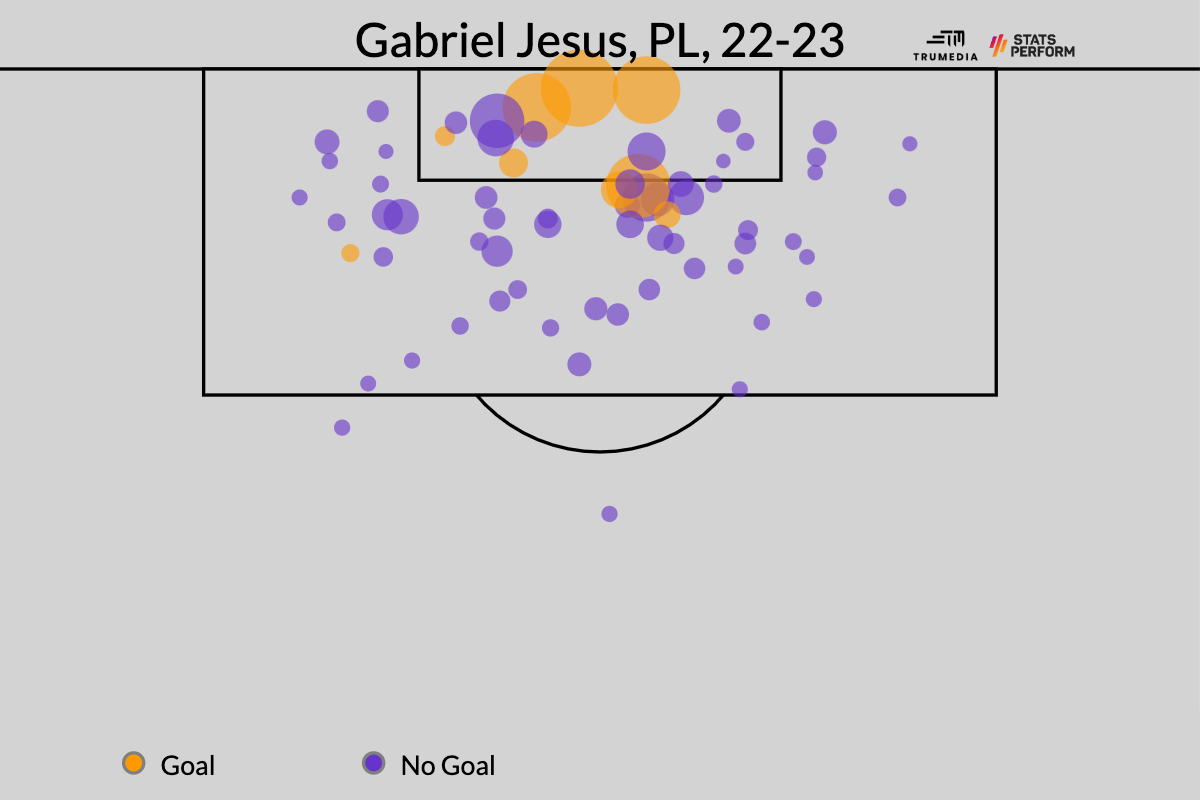Most transfers fail.
As Liverpool's former director of research Ian Graham put it, there are six ways a deal can go wrong: player isn't as good as you thought, player doesn't fit, player plays out of position, player isn't liked by manager, player gets hurt, player isn't as good as other players already on the team.
In Graham's elegant explanation, even if a club is 90% sure across all six potential hurdles for a given deal, the deal (0.9, to the sixth power) only has a 53% chance of working out. When you consider that most teams aren't putting that level of thought into their moves -- and certainly aren't approaching that level of quantified certainty across those deliberations -- then it's no wonder that most transfers fail to move the needle.
Just take this past summer. There were 15 moves for transfer fees of at least €50 million, and those 15 players have played 57% of the available domestic minutes so far this season. These moves averaged out to about 12% of the acquiring team's annual revenue. So, they're coughing up more than 10% of their revenue just on the fees required to break a player's contract with his previous club. This isn't including the salaries they're then paying the players. And all they've gotten so far are guys who are on the field barely more than half of the time.
So, let's take a look back at each of these 15 moves. What did we know about them last summer, and what have we learned in the past 10 months? We're going to grade each move based on what we knew at the time, and update it based on any new information from the 30-plus games we've seen this season.
Note: All data comes from the site Transfermarkt. Transfer fees aren't the only costs of these moves, but they're the largest chunk, and the data is the most widely available.


Antony: €95m from Ajax to Manchester United
Age: 22
Percent of minutes played: 52.3
Fee as percentage of annual club revenue: 13.8
This fee is right in range for what clubs tend to pay for an established young player with the potential to become a star. Not the fee itself -- that would be the 14th-most-expensive deal in the history of the sport -- but when you control for club revenue, it doesn't look quite as bad.
As revenues continue to rise year after year, top clubs tend to pay between 10% and 15% of their annual revenue for top prospects. Yes, the Antony transfer cost United more than, say, Zinedine Zidane cost Real Madrid (€76m) in 2001, but the Zidane fee represented more than half of Madrid's annual revenue that season.
- Stream on ESPN+: LaLiga, Bundesliga, more (U.S.)
Now, it's true that clubs aren't necessarily thinking in these terms -- and they're certainly not accounting for the moves in these terms, as their bookkeepers divvy up the transfer fee across the length of the player's contacts -- but this is a more useful way of looking at the fees than just staring at the massive, decontextualized numbers. That said, there wasn't a lot to like about this deal from the outside.
We should always be skeptical of a manager signing a former player. What are the chances Erik ten Hag just happened to be coaching the best player in the world for the role United needed to fill? Less than 1%? And when you're paying nearly 15% of revenue for a player, you're expecting that player to become a starter and a star. However, I'm not really sure there was all that much to suggest that Antony was on that kind of trajectory.
At Ajax, he averaged 0.58 non-penalty expected goals+assists per 90 minutes (npxG+A/90) in the Eredivisie. That would rank 14th in the Premier League this season, but Ajax have a massive talent and financial advantage over the rest of the league, and the league itself tends to inflate attacking numbers of players before they move on to a bigger league.
To pay nearly €100m for an Eredivisie attacker, you'd want his number to look more like Lionel Messi's than Gabriel Martinelli's.
Process grade: D-
Antony has only played about half of United's minutes so far this season, and in the Premier League his attacking production has dropped down to 0.44 npxG+A/90 -- the same as Leon Bailey and Dominic Solanke. It's unclear that he has the athleticism required of top wingers these days, and to the naked eye, he slows play down too often and seems too predictable in how often he cuts onto his strongly favored left foot.
He provides some value out of possession, but at least so far, United could be getting the performance they've gotten from Antony for about a fifth of the cost. He has been, at best, a league-average starting attacker so far.
Update: D-


Wesley Fofana: €80.4m from Leicester City to Chelsea
Age: 21
Percent of minutes played: 31.3
Fee as percentage of annual club revenue: 14.2
The good: Fofana is super-young at a position where players tend to peak a little bit deeper into their 20s than others. He's also French; I'm only being half-serious about that, but I really do think there's a tiny bit of predictive power in French center-backs. They tend to be pretty good! And Fofana started 27 games for the fifth-place team in the Premier League at age 19.
The bad: That season was two years ago because he missed most of last year after breaking his leg and tearing ligaments in his knee.
Julien Laurens believes Chelsea chairman Todd Boehly should let the right people at Chelsea lead the club as they have the experience to do it.
Given the good, this would've been a savvy deal had Chelsea bought low on a promising player coming off an injury. Instead, they paid... pretty much exactly the same transfer fee you might've expected had Fofana not gotten injured and had performed like one of the best center-backs in the league last season.
Fofana is worth taking a risk on, but we're grading the process here, and Chelsea operated like he was a sure thing.
Process: D-
Fofana has missed 20 games this season due to knee issues, and I think that 31.3%-of-minutes number is even lower than it looks considering center-backs typically don't get subbed out in matches. I wouldn't be shocked if Fofana becomes a star for Chelsea one day, but nothing that's happened so far this season warrants changing that initial grade.
Update: D-


Aurelien Tchouameni: €80m from AS Monaco to Real Madrid
Age: 22
Percent of minutes played: 61
Fee as percentage of annual club revenue: 11.2
That's a lot of money for a midfielder, but it also looks cheap in comparison to the recent or rumored nine-figure moves for Enzo Fernandez and Jude Bellingham.
Before signing with Madrid, Tchouameni was already starting matches for France, who have perhaps the deepest midfield in the world. He was only 22, and he checked all the basic analytical boxes: 99th percentile in Ligue 1 for tackles+interceptions per 90 minutes, 93rd percentile for ball recoveries and progressive passes, and 74th percentile for pass-completion percentage.
In other words, he was winning the ball a ton and playing adventurous passes without turning the ball over too often. Madrid also get a tiny bonus point for keeping him from going to Liverpool.
Process: B
If you haven't picked up on it yet, I'm a tough grader -- especially at this end of the market, where teams continually convince themselves there's way more certainty than actually exists. I can't really give out more than a B for an €80m midfielder, but: It's above average! Although Tchouameni has slowed down a clip after a recent injury dropped him from the starting XI, he still seems like he's going to be a starter for a Champions League-contending team for the next decade.
Update: B


Darwin Nunez: €80m from Benfica to Liverpool
Age: 23
Percent of minutes played: 53.8
Fee as percentage of annual club revenue: 11.4
This was a hefty fee for a player making a big leap from the Portuguese league. There also seemed to at least be a bit of a "this guy played well against my team" effect going on with this signing after Liverpool's Champions League quarterfinal matchup against Benfica. (Nunez scored in both legs of Benfica's 6-4 quarterfinal loss to the Reds.) Roberto Firmino, Mohamed Salah, Sadio Mane, Diogo Jota, and Luis Diaz were all ideal signings: low risk and high reward. Nunez, on the other hand, was high risk and high reward.
The risk came from the size of the fee and from the style of player. While all of the other forwards were comfortable in possession and interchangeable across the front three, Nunez completed just 73% of his passes at Benfica.
The reward: He posted elite underlying numbers at Benfica -- 0.94 npxG+A per 90 -- and had all of the physical tools to be dominant, too.
Process: C+
From a pure per-minute shot-production standpoint, this should get bumped up to an A+. Among all players across Europe's Big Five leagues with at least 1,500 minutes played, Nunez is fourth (0.93 npxG+A) behind only Karim Benzema, Kylian Mbappe and Messi. He's only turned his 12.1 expected goals (xG) into nine goals, but it's way too early to worry about the efficiency of his finishing; the shots, more likely than not, are going to start going in.

The reason it's not an A+ is that he's only played 53.8% of the minutes. Now, it's Year 1 and Jack Grealish played a similar minutes load last year before becoming one of Manchester City's key players this season, but there's still a lingering question of how Nunez fits into Liverpool's team. He's still not a great presser, especially compared to Jota and Cody Gakpo, who are two of the best in the world at it. Combine that with his lack of ability in possession, and it does seem like his presence in the lineup destabilizes Liverpool in both directions.
Nunez is so dangerous in the final third that it might not matter, but Liverpool's last-season shift in system does muddy the picture of where he might fit going forward.
Update: B-


Casemiro: €70.65m from Real Madrid to Manchester United
Age: 30
Percent of minutes played: 58.4
Fee as percentage of annual club revenue: 10.3
A well-run club just doesn't pay this much money for any 30-year-old player, especially a 30-year-old midfielder. The reason that 10% to 15% of revenue tends to go toward top young players is that you're partially paying for the potential of a full prime from that player. That's, of course, obviously not what you're getting when you sign a 30-year-old.
Process: D
Casemiro has absolutely improved United in the short term, but their defensive midfield options were so bad that I think plenty of other younger players would've also improved United in the short term while also providing the kinds of long-term benefits Casemiro can't. Counterfactuals matter when assessing these moves. Given how aging tends to work, this was likely to be Casemiro's best season for United, but he's played fewer than 60% of the league minutes for a team that needs every minute they can get.
He's never been known for his passing, but he's been especially poor on the ball this season. He's winning the ball a ton but only completing 77% of his passes -- 29th percentile for all Premier League midfielders. That's down from 85% with Madrid, and while that might seem like the result of a new tactical environment, completion percentage tends to be pretty sticky as players change teams. It's hard to control games when your holding midfielder is giving the ball away with nearly one out of every four passes.
Update: C+


Alexander Isak: €70m from Real Sociedad to Newcastle United
Age: 22
Percent of minutes played: 38.1
Fee as percentage of annual club revenue: 33
Based on the club's revenue for last season, this is by far the biggest outlay of this list -- and likely the biggest outlay of any club in Europe. Clubs typically spend around 20% of revenue on record transfers; Isak required a transfer fee considerably more than that.
Obviously, that doesn't tell the whole story. With Saudi Arabia's Public Investment Fund now bankrolling the club, Newcastle have the richest owners in professional sports. Spending doesn't mean the same thing for them that it means for almost everyone else.
Isak is the right age and played the right position for a massive investment. He'd started 70 games for Real Sociedad before his age-22 season, and he'd scored 30 non-penalty goals and added five assists. There was still a good deal of risk in this move -- Isak was by no means a guaranteed star -- but it was the right kind of risk for a team like Newcastle, one with unlimited money, but still no guarantee of Champions League matches, to make.
Process: B-
After struggling with injuries before the World Cup, Isak has been on fire since the midseason break. He hasn't played many minutes in total, and he's only started 13 games, but he's scored 10 goals and assisted one more. He's doing a little bit of everything on the attacking end, and he's one of 13 Premier League players to average at least 0.6 npxG+A per 90 minutes this season.
Based on what we've seen this season, Isak is way closer to stardom than I thought he was when Newcastle signed him.
Update: B


Matthijs de Ligt: €67m from Juventus to Bayern Munich
Age: 22
Percent of minutes played: 76.7
Fee as percentage of annual club revenue: 10.2
While De Ligt's career hasn't had quite the trajectory everyone expected when he was starring for Ajax during the Champions League run four years ago, he'd started 152 league games for Ajax and Juventus before his age-22 season. That's impressive at any position, but especially so at center-back where, as we've said already, players tend to peak a little bit later than all of the other outfield roles.
Given De Ligt's outlier level of experience and the potential of locking up one of your two or three center-back slots for a decade, the fee feels like it was on the lower end of what teams typically would pay for players of a similar profile. Hell, Juventus paid €85.5m to acquire the exact same player four years ago.
Process: B
De Ligt hasn't been as present as you'd hope a center-back would be, but he's still played the second-most minutes of everyone on this list. And when he's been out there, he's easily been Bayern's most reliable center-back this season. They can roll with him for the next 10 years and not really have to think about it. This is looking like a classic post-hype signing.
Update: B+


Marc Cucurella: €65.3m from Brighton & Hove Albion to Chelsea
Age: 24
Percent of minutes played: 54.6
Fee as percentage of annual club revenue: 11.5
I didn't get this one at the time ...
Process: D-
... and I still don't get it now. Cucurella was coming off one good season at Brighton playing a kind of utility role on the left side of defense. He wasn't the kind of player who could man a whole flank by himself; he was more of the so-called "elbow back," a conservative full-back who allowed the guy on the other side to push forward. These players are useful -- even necessary -- but they're complementary players, not the kind of potential star that Chelsea's outlay suggested they thought they might be getting.
On top of that, Chelsea's defense was a strength coming into the season. Sure, they needed some depth behind Ben Chilwell, but this wasn't a depth signing. Cucurella, though, has only played depth-player minutes, and he hasn't been particularly impressive when he's been out there, either. Add in Brighton's continued improvement after he left the club, and the move looks a little bit worse in hindsight.
Update: D-


Erling Haaland: €60m from Borussia Dortmund to Manchester City
Age: 21
Percent of minutes played: 84.5
Fee as percentage of annual club revenue: 8.2
Out of any move on this list, the Haaland transfer fee is the most misleading. These moves don't happen unless a player agrees to them, and Haaland agreed to this move in part because City made him one of the highest-paid players in the league. He's making something more than €20m a season, on top of the fee. The total cost is way more than €60m.
That said, he'd been dominant at every level and was one of maybe three 22-and-under players in the world to flash multiple-Ballon-d'Or-winner potential over multiple seasons. This was a deal.
Process: A
He's scored 51 goals this season. He might win the Ballon d'Or in the same year that Messi finally won the World Cup. If he stays healthy, there's something like a 50-50 chance that he goes down as the greatest striker in the history of the sport.
Update: A+


Richarlison: €58 million from Everton to Tottenham Hotspur
Age: 25
Percent of minutes played: 29.1
Fee as percentage of annual club revenue: 11.1
Spurs went into that "young star potential" range for a player who didn't really have that upside. At 25, you're acquiring a player in the middle of his prime and at Everton, Richarlison had been a solid Premier League attacker, never really putting up eye-popping numbers, but also adding some defensive quality from the front and providing a rare combination of ball carrying and aerial ability.
Given that the club already had a well-established front three of Harry Kane, Son Heung-Min, and Dejan Kulusevski, it seemed like they were paying for the certainty. This wasn't a potentially game-changing player; rather, it was someone who would provide a high baseline of performance when filling in for whoever else got hurt or needed a rest.
Process: C-
Spoiler alert: there is no certainty! There are too many variables to be confident that any transfer will work out. Richarlison has only scored one Premier League goal. In his defense, his underlying numbers are slightly better than they were at Everton. The near-total lack of production is more of a fluke than anything.
But he's only appeared in 29% of the Premier League minutes and it's not clear that a €20m player wouldn't have had the same impact. One year in, he doesn't appear to be a Champions League-level player.
Update: D-


Raphinha: €58m from Leeds United to Barcelona
Age: 25
Percent of minutes played: 61
Fee as percentage of annual club revenue: 9.1
This was a fine move for a fine player.
Process: C
And it's worked out ... fine. He's not a star, but he's been a reliable starter on the wing for a team that hasn't had reliable wing play in, like, a decade. He hasn't poured in goals or assists, but I think he's played a not-insignificant role in Barcelona's defense allowing just 11 goals through 33 games. He's one of the better defensive wingers in the world, and while that's not what Barcelona fans expect from their attackers, he's been good enough to play 61% of the minutes for a team that's going to clinch a LaLiga title with plenty of games to spare.
Update: C+


Lisandro Martinez: €57.37m from Ajax to Manchester United
Age: 24
Percent of minutes played: 69.1
Fee as percentage of annual club revenue: 8.3
This was one of the most annoying transfers I can remember. In case you're unaware: Martinez is short.
In one corner, you had people laughing at the idea that a club would even consider acquiring a sub-6-foot center-back. As if playing professional soccer were akin to riding a roller coaster, Martinez came in below the clown's hand and therefore there was no chance he'd succeed.
In the other corner, you had people laughing at the idea that a player's height might matter at all -- as if your physical attributes provided no upside or downside whatsoever. All that matters is if you can ball, or something.
I didn't love United signing yet another Ajax player -- this is one of the richest teams in the world, with their pick of nearly any center-back out there -- but given their resources, it wasn't a huge investment and it was a position of need.
Process: B-
Given these established stakes, every bad Lisandro Martinez game -- and there were some bad ones -- has become proof that a tiny center-back just wouldn't work in the Premier League. And every not-bad Lisandro Martinez game is proof that, actually, our short king might be the best center-back in the league.
The reality: He's a good player. He's not a superstar, and -- in part due to his physical limitations -- he's not the kind of player you plug in who immediately fixes your defense and your attack and allows you to build out the team in whatever way you want around him. That's what the truly elite center-backs provide. United, of course, didn't pay a fee that suggested Martinez would be that kind of player.
For a team that's been so bad at team-building since Sir Alex Ferguson left a decade ago, acquiring a young player who can play starter minutes is a win.
Update: B


Raheem Sterling: €56.2m Manchester City to Chelsea
Age: 27
Percent of minutes played: 53.7
Fee as percentage of annual club revenue: 9.9
Hand up: I thought Sterling would be Timo Werner, but just with, you know, lots of goals and lots of assists.
Process: B-
Sterling went to Chelsea to become more of a focal point than he was at City, but he's played a smaller share of Premier League minutes than in any season since he was 17 and still at Liverpool. He's only 28 now, and yet it seems like there's a decent chance all of those minutes have finally caught up to him.
- Last five seasons with Manchester City: 0.71 npxG+A per 90 minutes
- This season with Chelsea: 0.48 npxG+A per 90 minutes
In acquiring Sterling, Chelsea thought they were getting a proven Premier League superstar. But with every degree of perceived certainty comes a different kind of risk. The more minutes and seasons of high-level performance you have for a player, the more likely it is that he's approaching his decline. The transfer market is all about figuring out that balance, attempting to quantify both sides of the equation, and deciding how much each bet is worth.
Chelsea co-owner Todd Boehly has made some truly terrible bets since taking over the club, but the move for Sterling wasn't one of them. It just doesn't look like it's going to work out.
Update: C-


Gabriel Jesus: €50m from Manchester City to Arsenal
Age: 25
Percent of minutes played: 57.4
Fee as percentage of annual club revenue: 11.5
There were seemingly three outcomes to this move:
1. With worse teammates around him, Jesus doesn't get on the end of as many good chances as he did at Manchester City. Fewer chances combined with his spotty finishing craters his production, and Arsenal's center-forward struggles to score goals.
2. His off-ball ability scales down. He still gets the same number of chances, and he still converts them at a below-average rate, but he's so good at getting the chances that even a lower conversion rate still leads to a ton of production. In other words: exactly what happened at City.
3. His poor finishing proves itself to be a small-sample-size fluke and he actually starts to score more goals than expected. All of a sudden, Arsenal might have the best striker in the league.
Given what we know about how goal scoring works -- the main ingredient is off-ball movement and the ability to generate many good chances -- the first scenario seemed the least likely to me. Arsenal, who hadn't finished fourth since 2015, were getting a player who was a significant contributor to the best team in Premier League history, and he'd be playing the most premium position on the field.
Process: B+
And, well, guess what?
- His final five seasons with City: 0.77 npxG+A per 90 minutes
- His first season with Arsenal: 0.78 npxG+A
Jesus has been pretty much exactly who we thought he was. He's only scored nine non-penalty goals from 12.5 xG...

... but he gets and creates so many great chances, that he's still on 0.7 non-penalty goals+assists per 90 minutes -- the 10th-best mark in the league.
Update: B+


Jules Kounde: €50m from Sevilla to Barcelona
Age: 23
Percent of minutes played: 71.1
Fee as percentage of annual club revenue: 7.8
This was like the Raphinha move, but for a younger player with a ton of minutes under his belt and a much stronger track record of performing in Champions League-level teams.
Process: B
Kounde is Barcelona's Ben White: a pinched-in full-back who strengthens the team defensively but doesn't handicap the attack because he's so good at progressing the ball from deep. These players allow their teams' midfielders to break into the penalty area both because the defenders are covering the space behind the midfield and because they take some of the line-breaking responsibilities off of their plate.
Given that Barcelona couldn't really afford Kounde (and others) without selling off their future -- and given that they failed to even get out of their group in the Champions League and earn the much-needed revenue a deep European run would've provided -- there are a bunch of other questions surrounding this and their other moves. But I've already written about all of that.
In a vacuum, every team needs a player like Kounde.
